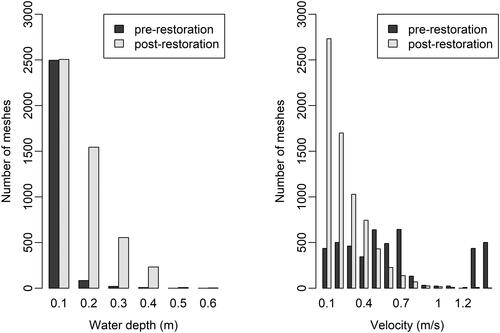Abstract
The mandate to maintain at least a good ecological status of all surface waters has led to increased river restoration projects across Europe in the past two decades. The aim is to re-establish the hydromorphological situation and reverse the damage to freshwater ecosystems. In this study, we evaluated the restoration measures in a small stream in the State of Saxony, Germany, using the Transient River Habitat Modelling for Macrozoobenthos (TRiMM). The model was established using the Physical habitat template, covering physical habitat variables (flow, substrate, and thermal regime). It also introduces the application of a fuzzy approach to investigate river physical conditions and their effects on biological indicators like macrozoobenthos. Three taxa, namely Ancyls fluviatilis, Ephemera danica, and Gammarus fossarum, with different habitat preferences, were used to investigate the river’s ecological conditions. The model simulated the natural flow conditions from spring to summer, before and after the restoration was implemented. The research indicated that the restoration of the studied river sections succeeded in providing suitable habitats for target taxa at varied discharge conditions.
Introduction
Habitats for aquatic species have suffered from anthropogenic activities (Vörösmarty et al. Citation2010), including water pollution, flow alteration, and morphology modification (Grizzetti et al. Citation2017; Bogardi et al. Citation2020). In Germany and the USA, only 2% of the surface waters are in their natural state (Jähnig et al. Citation2011; Guzelj et al. Citation2020). More than 60% of surface water bodies in the European Union (EU) have neither a good ecological nor a good chemical status (European Environmental Agency Citation2018). This draws attention of many countries to establish multiple regulations intended is to improve the quality of riverine ecosystems. In the EU, member states are legally obliged to achieve at least good ecological status for all water bodies in accordance with the Water Framework Directive – WFD (European Commission Citation2000). Furthermore, the severe hydrological and morphological impacts in many countries have led to increased hydromorphological restoration efforts across Europe (Umwelt Bundesamt River Restoration [UBA] 2017; Zingraff-Hamed et al. Citation2017).
Water flow and substrate, i.e. the hydromorphological template (Tatis‐Muvdi and Stamm Citation2019), form a physical habitat for aquatic biota to occupy. It provides information needed for river ecology assessment. Macrozoobenthos species are particularly useful in evaluating the disruption of this template, as they are one of the most widely used organisms in freshwater biomonitoring of altered hydraulic and physical habitat characteristics (Dolédec et al. Citation2007; Mérigoux et al. Citation2009; Wolter et al. Citation2013). This was one of the main stimuli behind the development of the Transient River Habitat Modelling for Macrozoobenthos – TRiMM (Tatis‐Muvdi and Stamm Citation2019). Using the physical habitat variables, this version of TRiMM aimed to analyze the long‐term limiting effect of hydromorphology on macrozoobenthos. In other words, it integrates information on flow regime, substrate, channel morphology, and current patterns to predict habitat suitability for macrozoobenthos taxa (Tatis‐Muvdi and Stamm Citation2019).
The use of river habitat suitability modellingFootnote1 to investigate rivers’ ecological functions based on hydraulic conditions has been studied since the 1970s (Dunbar et al. Citation2012; Theodoropoulos et al. Citation2018). For instance, the Instream Flow Increment Methodology (IFIM) approach (Bovee Citation1982) is widely used to predict the effects of discharge variations on habitats for aquatic species (Dolédec et al. Citation2007; Conallin et al. Citation2010; Macura et al. Citation2018). Initially, the habitat models targeted mostly fish species (e.g. Raleigh et al. Citation1986; Lobb and Orth Citation1991). Later, it was applied to zoobenthos (e.g. Jowett Citation2003; Van Broekhoven et al. Citation2006). The development of TRiMM was another contribution to river assessment based on habitat dynamics subjected to macrozoobenthos. TriMM’s inputs are time-dependent, so transient changes in the physical habitat due to hydro-morphological conditions are considered in the simulations.
Furthermore, river restoration is an attempt to recover the loss of aquatic habitats and improve their ecological conditions (UBA Citation2017). Ecological restoration in rivers includes removing and installing natural or artificial structures, channel widening, flow adaptation, riverbed modification, etc. These measures, however, do not guarantee positive outcomes (Bernhardt and Palmer Citation2011; Sundermann et al. Citation2011; Roni Citation2019; dos Reis Oliveira et al. Citation2020). To this end, habitat modelling was introduced as a tool for the ecological evaluation of restoration projects at many stages, including planning, evaluation, and post-restoration (Lange et al. Citation2015; Yao et al. Citation2017; Zingraff-Hamed et al. Citation2018; Theodoropoulos et al. Citation2020). Physical Habitat Simulation – PHABSIM (Milhous and Waddle Citation2001) was the first habitat model used to assess restoration measures (e.g. Gore et al. Citation2001; Booker and Dunbar Citation2004; Milhous Citation2007). Later, the Computer Aided Simulation Model for Instream Flow and Riparian – CASiMiR (Schneider Citation2001) was also used (e.g. Mouton et al. Citation2009; Lange et al. Citation2015; Zingraff-Hamed et al. Citation2018).
Effective restoration projects embrace important factors including river bed and hydrology evolution (Palmer et al. Citation2005; Yao et al. Citation2017). In habitat modelling, these factors are described as physical habitat variables, which affect species carrying capacities, including water depth, velocity, substrate, and cover (Jowett Citation2003; Conallin et al. Citation2010; Gopal Citation2013). Therefore, the aforementioned parameters were included in the transient habitat modelling in this study to provide a scientific basis for effective stream restoration. Moreover, the temperature distribution was also integrated into the model, since the temperature is known to affect habitat suitability for macrozoobenthos taxa (Caissie Citation2006; Schuwirth and Reichert Citation2013). The present study focused on three taxa, namely Ancylus fluviatilis, Ephemera danica, and Gammarus fossarum. Through a fuzzy logic approach, hydrodynamics, temperature, and sediment characteristics of the stream were linked with available knowledge on species’ preferences to evaluate the ecological situation of the studied river section pre- and post-restoration. The aim is to assess whether the restoration measures implemented succeeded in improving physical habitat suitability for the studied species and to test our hypothesis that hydromorphological and thermal fluctuations affect the habitat distribution patterns in the river.
Method
Study site and river characteristics
Mortelbach is a small stream located in the state of Saxony, Germany. The river, from a structural point of view, has a strong longitudinal zonation. The upstream stretch of the river flows through farmland, mostly without natural riparian vegetation, while in the middle it runs through forest and floodplain vegetation. However, the downstream segments are heavily modified, particularly within urban areas. The studied reach is in the city of Waldheim, where Mortelbach has a strongly modified morphology (Figure S1 in Supplementary material S1). The assessment results using macrozoobenthos showed a predominantly moderate to poor ecological condition (Deutsche Vereinigung für Wasserwirtschaft, Abwasser und Abfall [DWA] 2018). In order to improve the ecological situation of the river, its sections were revitalized referring to structural alteration measures such as pools, riffles, and riparian and aquatic vegetation (). The restoration was part of the Bundesministerium für Bildung und Forschung (BMBF) research project ‘In_StröHmunG’Footnote2, which aimed to improve the hydromorphological quality of the stream with the expectation of enhanced ecological status. Rehabilitation measures were constructed in 2018 over a length of approximately 220 m. shows four different sections with restoration measures implemented, namely D1, M1, D2, and M2 (from downstream to upstream).
Figure 1. Location of the study site with an overview of Saxony river systems and Mortelbach within the city of Waldheim showing the four 4 restored river sections (D1, M1, D2, and M2, downstream to upstream) with structural measures such as pools, riffles, and riparian/aquatic vegetation.
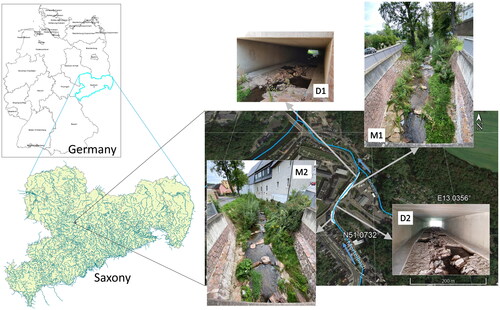
Mortelbach is characterized by very low discharges, which occasionally occur in the dry season and were proved to be significant pressure on this river (DWA Citation2018). The river has a mean annual low flow, MALF of 0.041 m3/s and a mean annual flow, MAF of 0.1 m3/s while reaching a mean annual high flow, MAHF of 4.85 m3/s during flood events. It should be noted that the values are the results of complex water balance models for water bodies in Saxony under the project KLiWES (LfULG: Wasserhaushaltsportal Sachsen – Durchflusskennwerte und Querbauwerke Citation2015). As the river is currently gauged, this study will use actual discharge time series during the spring and summer of 2021, when flow peaked at 0.93 m3/s and was at its lowest at 0.02 m3/s (Figure S2 in Supplementary material S1). During the study period, Mortelbach experienced low flow conditions (<MAF), which accounted for more than 70% or 129 days, of which 45 days were critical low flow (<MALF). The water temperature was also monitored during the studied period showing a mean temperature of 7 °C in spring (March to May) and 15.7 °C in summer (June to August).
Target species
A. fluviatilis, E. danica, and G. fossarum (Figure S3 in Supplementary material S1) were selected as target species upon consultation with a hydrobiologist. Based on historic information and recent surveys, these species have been present in Mortelbach before and after the restoration project. Moreover, most habitat preferences for these species can be found in the freshwater ecology database (Schmidt-Kloiber and Hering Citation2015). Thus, they are suitable to detect an improvement in the river stretch and assess the effects of restoration measures.
A. fluviatilis are rheobiont organisms, preferring coarser substratum like stones, boulders, and bedrock. They are herbivores grazing on diatoms and various periphyton materials (Calow Citation1973) and do not occur in freezing rivers and prefer warm water. E. danica prefer reaches with lower water velocity as they are rheo- to limnophilic species (Schmidt-Kloiber and Hering Citation2015; Vilenica et al. Citation2017). They are most abundant in the sandy riverbed and where silt accumulates below macrophytes (Bennett Citation2007; Vilenica et al. Citation2018). They feed by filtering or collecting fine organic particles from the water column (Grzybkowska et al. Citation2016). G. fossarum are rheophilic species that prefer high currents (Schmedtje and Colling Citation1996) and can be found in wide ranges of grain-size materials but prefer coarse gravel, stone, boulders, and various types of organic covers (Tachet et al. Citation2010). They are identified as shredders, feeding mainly on leaves (Luštrik et al. Citation2011; Beracko et al. Citation2012).
Substrate types
TRiMM categorises substrate types into two categories: mineral and organic substrate, which were adapted from Schmedtje and Colling (Citation1996). In Mortelbach, the riverbed consisted primarily of stones and boulders (>20 cm, macrolithal), with some organic structures like terrestrial plants (macrophytes) as cover. Moreover, the river was channelized, so the majority of the riverbed was covered with an artificial structure made of concrete. The restoration later created substrate diversity such that the river bed now includes not only macrolithal but also coarse gravel (2–6 cm, microlithal) and fine gravel (0.2–2 cm, akal). Also, the organic substrate diversifies after restoration. Four organic substrate types were identified during the survey, including algae, macrophytes, particulate organic matter, and some branches and deadwood.
Modelling tools
Hydrodynamic and water temperature modelling
To investigate a suitable habitat for macrozoobenthos taxa, two-dimensional (2D) hydrodynamic and water temperature modelling of the river stretch were established. The 2D modelling is well suited for habitat modelling, as it can quantify spatial variations of flow conditions affecting biota (Papadaki et al. Citation2017). Thus, it is preferable for a study of hydraulic-habitat effects from a change in river structures like restoration (Dunbar et al. Citation2012; Fjeldstad et al. Citation2012).
For this work, the model Sedimentation and River Hydraulics–Two-Dimension (SRH-2D) version 2 (Lai Citation2008), which solves shallow-water equations using a finite-volume numerical method, was used. The pre-processing (e.g. mesh generation, nodestring boundaries, and material properties identification) and post-processing of the data (e.g. results visualization and exportation) were carried out using the Surface water Modelling System (SMS) software version 13.1 (AQUAVEO Citation2021). The computational domain covered both the main channel and riverbank, and 2D-depth averaged hydraulic properties (e.g. water depth, flow velocity, and temperature) were calculated. Refined meshes were required to account for different hydraulic zones in the restored stream with complex geometry and to obtain locally detailed hydrodynamic results that influence the results of the habitat model. Thus, the modelled domain was set up using high-resolution DEM, resulting in an unstructured mesh with 221,507 triangular and quadrilateral elements. The model was validated with measured values at MAF, and the calibration was performed by adjusting Manning’s coefficient for roughness until the predicted values closely matched the observed ones. Subsequently, the Root Mean Square Error (RMSE) of the modelled water depths was 0.038 m, and the R2 was 0.85. Moreover, the predicted temperature was compared with observed temperature data over the course of 24 h in spring and 24 h in summer, and the results were fairly good (R2 = 0.94 and RMSE = 1.1 °C).
To evaluate the restoration measures, a comparison with the pre-restoration state was made. For the unrestored scenario, however, the stream geometry was a simple channel with a total of 30,904 elements (Figure S4 in Supplementary material S1). Unrestored Mortelbach was modelled in 2015 using HYDRO_AS-2D version 3 (Nujic Citation2003). This model was calibrated and validated with measured water levels (Schulz Citation2015). It was then used as a reference for model calibration (by adjusting Manning’s values) in this study employing SRH-2D. The average deviation of water depth was 0.04 m, and R2 was 0.92. The measured temperature data before the restoration were not available for comparison. However, the restored state of the river did not show significant spatial variation in temperature distribution (<1 °C deviation), despite additional restoration structures (more complex geometry). The same spatial distribution pattern was observed in the modelling results of pre-restoration scenario (straightened channel). It is, therefore, assumed that the temperature results of this model are reliable.
The inflow boundary was the daily discharge and temperature obtained from the gauge located approximately 20 m upstream of the modelled domain (above the M1 section). A local slope was applied for the downstream boundary. Hydrodynamic and temperature modelling parameters setting is shown in Table S1 in Supplementary material S1.
The hydrodynamic and temperature modelling were run mainly to obtain a physical habitat description of the river, i.e. the variations of water depth, flow velocity, and water temperature. These variables were further integrated into habitat modelling to derive habitat suitability for macroinvertebrates. Two models were run using SRH-2D, the first for the pre-restoration scenario and the second for the post-restoration scenario. Flow and temperature variations from March to August 2021 were considered. The applied discharge time series only cover MALF and MAF, but not MAHF flow conditions. However, Mortelbach has experienced long periods of low flow conditions (DWA Citation2018). According to KLiWES’s daily discharge data from the water balance model of Mortelbach (LfULG Citation2015), only 5% of high-flow events (Q > 1 m3/s) occurred from 1961 to 2010. Therefore, the discharge time series used in this study (Figure S2 in Supplementary material S1), in which the flow ranges from 0.02 m3/s to 0.93 m3/s, provides an adequate basis for assessing the ecological changes caused by restoration structures and provides information about the ecological impact of the regional hydrological trend of descending flow discharges.
Habitat modelling
Habitat suitability simulations for A. fluviatilis, E. danica, and G. fossarum were done using TRiMM. The simulations were conducted for both scenarios: the current situation in Mortelbach (restoration implemented) and the situation before restoration (channelized river segments; see Figure S1 in Supplementary material S1). A total of six simulations (3 taxa × 2 scenarios) were modelled. The model’s spatial resolution was 0.25 m, and for each cell, TRiMM calculated the habitat suitability index (HSI) for the species, which ranges from 0 to 1. In TRiMM, the temporal resolution of one day was applied so that the daily spatial variation of habitat suitability of the river reach from spring to summer could be analyzed.
TRiMM uses five habitat parameters as described in the physical habitat template (Poff and Ward Citation1990), including water depth (H), velocity (V), temperature (T), mineral substrate (S), and organic substrate (C). The first three parameters were obtained from hydrodynamic and temperature modelling, while substrate information was obtained from an estimation of dominant grain sizes and organic cover from the field survey. Due to the relatively low discharge during the study period, it was assumed that both mineral and organic substrates remained constant. Consequently, substrate maps were generated to represent each observed substrate types.
The fuzzy logic approach was applied to calculate the habitat suitability index (HSI) in TRiMM. It linked physical habitat variables with the habitat requirements of the target taxa. Fuzzy sets were classified based on five ecological quality classes defined by the EU WFD. Therefore, the numerical values of habitat variables were converted into linguistic terms: ‘very low’, ‘low’, ‘medium’, ‘high’, and ‘very high’ (). This fuzzy description of variables is well suited to represent imprecise ecological information (Equihua Citation1990; Salski et al. Citation2009). The numerical values of the input variables (depth, velocity, and temperature) were converted to overlapping trapezoidal membership functions (fuzzy sets). Hence, each value of these variables can belong to one or more fuzzy sets in the means of membership degree, ranging from 0 to 1. Substrates, on the other hand, were converted to singleton membership functions based on substrate types. Therefore, each value can be assigned to one set.
Table 1. Fuzzy sets of habitat variables and their descriptions
In a fuzzy system, IF-THEN rules are used to quantify the interaction between antecedent variables and establish a fuzzy description of a consequent variable. In so doing, all possible combinations of habitat variables (), which define the habitat requirements for each species are determined as fuzzy rules. In TRiMM, fuzzy rules were set based on the available ecological preferences database of freshwater macrozoobenthos (Schmidt-Kloiber and Hering Citation2015). The preferred habitat conditions of all target species (in terms of their physical characteristics) are summarized in Table S2 in Supplementary material S1. For example, A. fluviatilis prefer coarse gravel, stones, cobbles, boulders, and bedrock with grain sizes >2 cm (Moog et al. Citation1999). They are abundant in the area in which the water is 0.2 m to 0.5 m deep (ÓHare Citation1999). Also, they prefer algal or macrophyte covers and zones with moderate to high currents (Tachet et al. Citation2010). It has also been observed that the species have a central tendency temperatureFootnote3 of 16.58 °C (Halle et al. Citation2016). The preference of each input parameter is matched with its fuzzy sets so that preferred sets can be determined and the rule can be formulated according to which the output is ‘very high’ habitat suitability, such as ‘IF mineral substrate is Very high AND organic substrate is Low AND depth is Medium AND velocity is Medium AND temperature is Medium THEN habitat suitability is Very high’. lists examples of fuzzy rules with different antecedents and consequents determined in this study (a full list is in Supplementary material S2).
Table 2. Examples of fuzzy rules determining habitat requirement for A. fluviatilis
Results
Hydrodynamic and temperature simulations
The simulation results indicated that in the restored reach, there were flow-hydraulic effects around the in-stream structures, forming new hydraulic zones such as pools (deep, slow-flowing) and riffles (shallow, fast-flowing) areas. Changes in water depth and velocity were observed even at low discharge. shows the results of SRH-2D models for water depth, velocity, and temperature before and after restoration at MALF. The hydraulic conditions of the restored reach have changed dramatically due to the topographical changes, resulting in a varied spatial distribution of depth and velocity. Before restoration, the poor morphological conditions resulted in homogenized depths and velocity paths, which changed due to the instream structures ().
Figure 2. Spatial distribution of water depth, velocity, and temperature before restoration (a) and afterrestoration (b) at MALF = 0.041 m3/s.
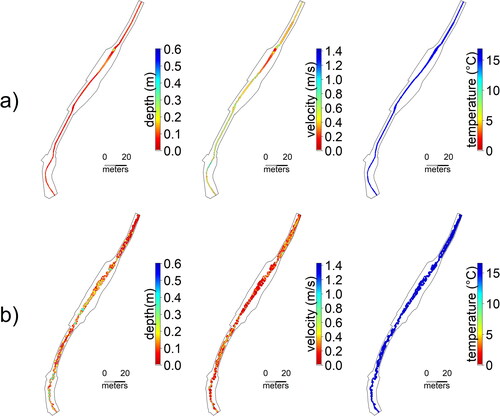
Figure 3. An example of the spatial distribution of velocity vectors showing changes in flow field due to instream structures in Section M1 before restoration (a) and after restoration (b) at MALF = 0.041 m3/s.
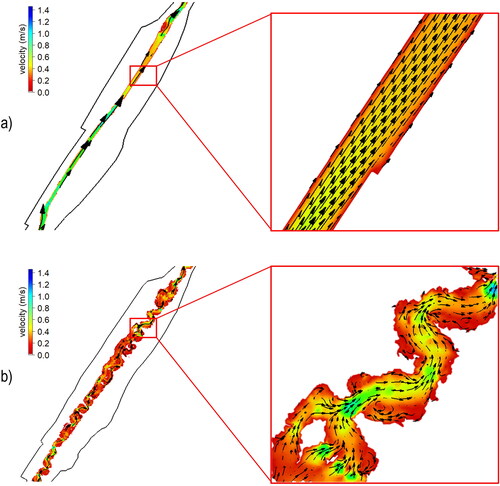
Moreover, only 7% of the river reach area had a water depth of more than 0.1 m at low flow condition, with the velocity mostly being between 0.5 m/s and 0.7 m/s. After restoration, the area increases to 50%, resulting in reduced velocities (mostly lower than 0.5 m/s). shows a frequency distribution of depths and velocities for the two scenarios at MALF. It should be noted that in both cases no spatial changes in temperature values were not observed since the study reach is rather small, being only 3 m in width and 220 m in length without confluence. This was also confirmed by the data collected from the temperature loggers placed at various points along the river reach after restoration. However, for long-term habitat dynamics, spatial variation will not be the only factor affecting the river’s habitat supply for species.
Restoration effects on habitat suitability at varied discharges
Overall, habitat restoration had a positive impact to some extent, reflected in a decrease in low habitat suitability classes (0.2 < HSI <0.4) and an increase in medium-to-high habitat suitability classes (0.4 < HSI <0.8) for all species at ranges of discharge during the study period (). In the critical low-flow situations (<MALF) positive effects were observed for A. fluviatilis. The median of the low-suitability habitat areas decreased by 17.7%, while high-suitability areas were increased by 13.8%. The conditions also positively influenced habitats for E. danica, as there was a huge decrease (62.1%) in average low-suitability habitat.
Figure 5. Box plots comparing different habitat suitability index classes for three target taxa with discharge classes at the river site. < MALF: 0.02–0.041 m3/s; MALF–MAF: 0.041–0.1 m3/s; > MAF: 0.1–0.93 m3/s. pre and post denote pre- and post-restoration, respectively.
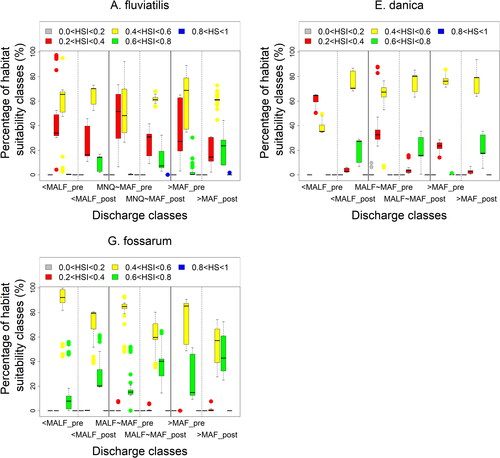
A similar trend was observed in the low to medium discharge range (MALF–MAF). For A. fluviatilis, there was a reduced median of low suitability areas (0.2 < HSI < 0.4) by −20.7%. Changes were also observed in the suitable habitats for E. danica: the number of areas with low suitability decreased by −28.8%. Additionally, in the higher flow condition (>MAF), the effects on A. fluviatilis’s and E. danica’s habitat were a rise in high suitability areas of 23.3% and a drop in low suitbaility areas of 20.5%, respectively.
For G. fossarum, the river conditions facilitated their occurrence, as the majority of the river reach was in medium-to-high suitability even before rehabilitation. The measures further improved the conditions, as evidenced by an increase in the high suitability areas from 17.8% to 20.2% in critical low conditions, from 15.2% to 40.3% between low and medium flow, and from 14.8% to 42.9% in higher flow (>MAF). In Mortelbach, extreme habitat conditions (very low or very high suitability) were rarely observed for three target taxa. Nothing has changed in this regard even after the construction of the in-stream measures. This is because the studied species have an affinity for a wide range of physical conditions, and Mortelbach during the simulation period did not suffer from harsh conditions such as extremely hot temperatures or extremely high water events. Simultaneously, the river conditions in this period did not coincide with the maximum suitability for target species.
Spatiotemporal distribution of habitat suitability
The number of overall habitable spaces for target species in the study reach increased after the restoration project (). These areas were particularly high during the peaks, which could be explained by the higher wet areas from high flow volumes. It is noteworthy that restoration structures did not only increase total habitat areas but also their quality. The decline in low suitable areas was observed for both A. fluviatilis and E. danica, and a big chunk of medium suitable areas was found after rehabilitation. Moreover, the number of high suitable areas were noticeably higher in the post-restoration scenario. These high suitability areas were mostly enlarged after the peak in May (Qmax = 0.93 m3/s) and continuously found during the summer. The reason for this is the increase in temperature (>10 °C) after May, which provided higher habitat suitability for species. This condition was not observed in the pre-restoration case. The reason was that the substrate composition was less diverse and the distribution of depths and velocities was not in favour of the species, even though temperature and discharge were the same.
Figure 6. Habitat areas of Mortelbach with different suitability classes during the study period from spring to summer 2021 for three species of macrozoobenthos with (_post) and without (_pre) restoration measures.
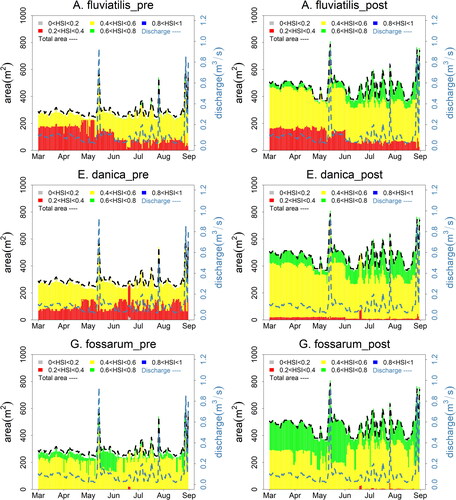
As a result of the stream’s flow and thermal regime, morphology, and substrate distribution, the spatiotemporal supply of suitable habitats for target species varied. The transient habitat simulations integrating water temperature revealed that the same discharge can lead to different habitat distributions along the river reach. This emphasizes the importance of temperature effects on habitat, particularly seasonal temperature fluctuations that alter distribution patterns of habitat suitability (Thepphachanh and Stamm Citation2023). However, river restoration has improved the distribution of habitat suitability for benthic species compared to the previous condition (without in-stream structures). shows variation in habitat suitability for taxa at near-dry flows (Qmin = 0.02 m3/s) on two different days during the study period at current conditions (after restoration) with distinguished habitat distributions. The low suitability area for A. fluviatilis on 1 May (137.6 m2) was much higher than that on 15 August (58.1 m2). For E. danica, low habitat suitability areas slightly increased from 22.6 m2 to 38.5 m2. Interestingly, the habitat quality for G. fossarum was the highest on 1 May (229.1 m2) compared to the other days in this near-dry condition.
Figure 7. Habitat Suitability Index map for a) A. fluviatilis; b) E. danica; c) G. fossarum at the minimum discharge (0.02 m3/s) on two different days at the current situation (different restoration measures in D1, M1, D2, and M2). The colour represents each habitat suitability index class (grey: 0< HSI ≤0.2; red: 0.2< HSI ≤0.4; yellow: 0.4< HSI ≤0.6; green: 0< HSI ≤ 0.8; blue: 0.8< HSI ≤1).
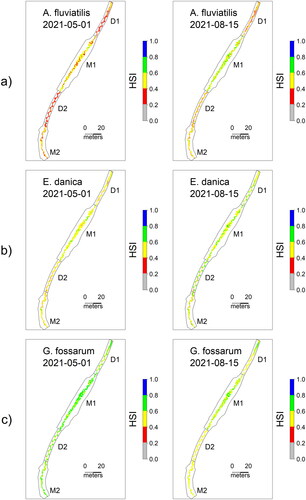
The results also indicated that higher suitable habitat areas were concentrated in section M1. This was expected as M1 (after restoration) had a broader range of habitat types as well as organic substrates such as macrophytes, woody branches, and organic matter, while cemented bottoms remained in other sections, specifically in D1 and D2 ().
The habitat modelling results of three benthos taxa in the current post-restoration situation also revealed that a large number of habitat areas occurred frequently in the summer. The number of high suitability areas were particularly higher during the flood days () due to an increase in wet areas. For A. fluviatilis, the largest total habitat area occurred at the end of August 2021 when the flow was 0.85 m3/s as 44.3% of the area was in high suitability, followed by 53.4% medium suitability (). The condition also provided the highest suitability for G. fossarum as 72.4% of the area was in high suitability, 27.6% was medium suitability, and no low suitability area was found. However, the condition provided a majority of medium suitability habitats for E. danica (73.9%).
Figure 8. Habitat Suitability Index map for three target species showing the post-restoration situation in summer at the discharge of 0.85 m3/s. The colour represents each habitat suitability index class (grey: 0< HSI ≤0.2; red: 0.2< HSI ≤0.4; yellow: 0.4< HSI ≤0.6; green: 0< HSI ≤ 0.8; blue: 0.8< HSI ≤1).
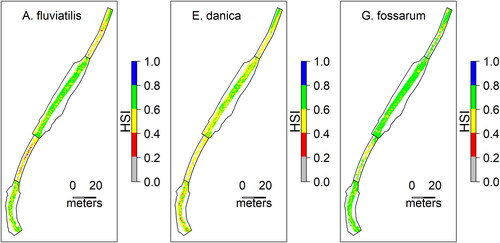
Discussion
River restoration effectiveness and its evaluation
Restoration effectiveness is often assessed using biotic responses to changes in physical habitat conditions (Manfrin et al. Citation2019; Theodoropoulos et al. Citation2020). These responses can be determined using long-term monitoring data to identify changes in target species (abundance, diversity, etc.) caused by restoration measures (Kail et al. Citation2015; Yao et al. Citation2017). Biological monitoring can be a time- and cost-consuming process. Therefore, an alternative numerical simulation may be a practical tool for quantifying the effects of restoration measures on the species (Lange et al. Citation2015; Theodoropoulos et al. Citation2020).
In this study, aquatic habitat was analyzed in terms of physical habitat suitability for species using habitat modelling. It is important that the restoration has a positive effect across a range of discharges, and the restored reach should provide suitable habitats for species at all times. In other words, effective habitat restoration should ensure that there is no habitat shortage on any given day, where areas of good habitat disappear completely. Therefore, this study evaluates not only the spatial distribution of habitat suitability at specific flows but also the temporal variability of habitats over a discharge and temperature spectrum. The long-term simulations of habitat modelling from spring to summer showed that diurnal temperature fluctuations led to changes in habitat suitability, even if discharge remained the same. Nevertheless, the habitat for the macrozoobenthos has increased as a result of the river restoration compared to the situation before the restoration. This is due to the in-stream measures that increase hydraulic and substrate diversity and thus promote beneficial for ecological recovery (Miller et al. Citation2010; Kail et al. Citation2015).
Changes in habitat suitability and habitable areas
A comparison of the habitat simulations of pre- and post-restoration conditions clearly shows that the restoration increased habitat quantity and quality for the target species both in spring and summer at the study site. The primary factors contributing to these habitat changes before and after the ecological river restoration project were: 1) the changes in hydraulic conditions, resulting in the varied spatial distribution of water depth and velocity; and 2) changes in river bed structures, which diversified substrate compositions, establishing new ecologically usable areas for species.
Before restoration, a long period of low suitable areas was observed for A. fluviatilis and E. Danica. For A. Fluviatilis, the worst condition with low suitability areas of more than 80% on the 12 days of low discharge (Q < 0.04 m3/s). On the other hand, the conditions for E. danica were not as severe as for A. Fluviatilis, as the period when the river mainly provided low suitability (>80% of the area) lasted only 3 days during which the temperature exceeded 18 °C. The conditions dramatically improved after restoration. Predominantly, the river offered medium suitability areas for both species. Area with low suitability for A. fluviatilis persisted over a longer period-of-time, but accounted for a smaller proportion of the total habitat (<40%).
Additionally, it was observed that habitat availability (habitat area) increases with increasing flow. However, the higher number of habitat areas do not imply that all are in good condition (at least of medium suitability). It should also be noted that this study focused on natural flow conditions in a supposedly dry year. The highest peak was at 0.93 m3/s, which is much lower than the mean high-flow discharge calculated for this river (MAHF = 4.85 m3/s). Moreover, since the highest suitable area for A. fluviatilis and G. fossarum occurred at 0.85 m3/s, it can be assumed that if the flow is too high (above a certain threshold), hydraulic conditions are no longer suitable for occurrence of the species and the suitability of the habitat could be drastically reduced (Cabaltica et al. Citation2013; Lang et al. 2015).
Applied methodology
The findings support our hypothesis in this study. Combining time-dependent information on the hydromorphology and thermal regime of the stream reveals the dynamics of physical habitat suitability. The model results showed seasonal fluctuations in habitat suitability, which can help disentangle the influence of temperature and discharge on habitats, since the study used a constant substrate (Thepphachanh and Stamm Citation2023). A river with a dynamic substrate would create even more distinct habitat suitability patterns, and a transient habitat model would be able to capture these variations. Nevertheless, the key components of the strategy relied on the hydrodynamic models, habitat preference data, and fuzzy-ruled systems.
In this study, the calibration of SRH-2D demonstrated the sufficient accuracy of the model in describing the hydraulic variations at the scale intended for the study. Calibrated Manning’s values produced a satisfactory agreement between measured and observed values for post-restoration simulation. The pre-restoration scenario was compared with validated HYDRO_AS-2D model results due to the lack of observation data at the restored area. However, since the river was a straight channel without complex structures, the results of the hydrodynamic model were sufficient for the study’s objective of comparing the influence of restoration measures on habitat distribution.
The fuzzy method in this study is based on existing knowledge of the ecological preferences of macroinvertebrates (Schmidt-Kloiber and Hering, Citation2015). This public database is useful in assessing the influence of environmental factors on habitats. However, the uncertainty of the preference parameters must be treated and assessed carefully, particularly when translating the preference into fuzzy systems. In this study, the models’ predictive performance was assessed using biotic sampling data, which indicated adequate accuracy in determining habitat suitability classes for targeted macrozoobenthos taxa (see Figure S6 in Supplementary material S1).
It should be emphasized that the habitat simulations for this study were specific to Mortelbach and based on five important physical habitat parameters, including depth, velocity, temperature, mineral substrate, and organic substrate (cover). However, the methodology can be applied to other streams with different conditions by adapting fuzzy membership functions and rule sets to the target species.
Conclusion
This model-based study evaluates how restoration structures affect the habitat suitability of different macrozoobenthos in Mortelbach, a small river in Saxony, Germany. The evaluation period extends from spring to summer 2021, i.e. 3 years after the construction of the rehabilitation structures. Using TRiMM, two scenarios of Mortelbach were simulated, one with pre-restoration conditions and another with post-restoration conditions. The results show optimistic outcomes of stream restoration, benefiting benthic species by providing more habitable spaces and improving habitat quality even during dry periods.
The modelling approach combines unsteady 2D hydrodynamic and temperature modelling with morphological data in habitat modelling, providing a scientific basis for river ecological management. Incorporating temperature dynamics and considering time-series data enables the assessment of habitat dynamics that is often overlooked in standard habitat simulations. Therefore, the application of the model is not limited to post-restoration impact assessment. It can also be applied to the design, planning, and optimization phases of restoration or river assessment.
Supplemental Material
Download PDF (1.5 MB)Disclosure statement
No potential conflict of interest was reported by the author(s).
Notes
1 “Habitat modelling” is used interchangeably with “habitat suitability modelling” in this article.
2 Innovative Systemlösungen für ein transdisziplinäres und regionales ökologisches Hochwasserrisikomanagement und naturnahe Gewässerentwicklung.
3 A mean summer water temperature value at which the taxon’s aggregated relative abundance equals 50%, characterising the centre of its ecological distribution (see Sundermann et al. Citation2022 for detailed calculation method).
References
- AQUAVEO. 2021. SMS – the complete surface-water solution [software]. [cited 2021 April 26]. http://www.aquaveo.com/software/sms-surface-water-modeling-system-introduction.
- Bennett C. 2007. A seven year study of the life cycle of the mayfly Ephemera danica. Freshwater Forum. 27:3–14.
- Beracko P, Sýkorová A, Štangler A. 2012. Life history, secondary production and population dynamics of Gammarus fossarum (Koch, 1836) in a constant temperature stream. Biologia. 67(1):164–171. doi: 10.2478/s11756-011-0148-5.
- Bernhardt ES, Palmer MA. 2011. River restoration: the fuzzy logic of repairing reaches to reverse catchment scale degradation. Ecol Appl. 21(6):1926–1931. doi: 10.1890/10-1574.1.
- Bogardi JJ, Leentvaar J, Sebesvári Z. 2020. Biologia Futura: integrating freshwater ecosystem health in water resources management. Biol Futur. 71(4):337–358. doi: 10.1007/s42977-020-00031-7.
- Booker DJ, Dunbar MJ. 2004. Application of physical habitat simulation (PHABSIM) modelling to modified urban river channels. River Res App. 20(2):167–183. doi: 10.1002/rra.742.
- Bovee KD. 1982. A guide to stream habitat analysis using the instream flow incremental methodology. Instream Flow Information Paper 12. U.S. Fish and Wildlife Service. USA.
- Cabaltica AD, Kopecki I, Schneider MC, Wieprecht S. 2013. Assessment of hydropeaking impact on macrozoobenthos using habitat modelling approach. Civil Environ Res. 3(11):8–16.
- Caissie D. 2006. The thermal regime of rivers: a review. Freshwater Biol. 51(8):1389–1406. doi: 10.1111/j.1365-2427.2006.01597.x.
- Calow P. 1973. The food of Ancylus fluviatilis (Müll.), a littoral stone-dwelling, herbivore. Oecologia. 13(2):113–133. doi: 10.1007/BF00345644.
- Conallin J, Boegh E, Jensen JK. 2010. Instream physical habitat modelling types: an analysis as stream hydromorphological modelling tools for EU water resource managers. Intl J River Basin Manage. 8(1):93–107.
- Deutsche Vereinigung für Wasserwirtschaft, Abwasser und Abfall [DWA]. 2018. StröHmunG–Innovative Systemlösungen für ein transdisziplinäres und regionales ökologisches Hochwasserrisikomanagement und naturnahe Gewässerentwicklung: Abschlussbericht des BMBF-ReWaM-Projektes In_StröHmunG. Deutschland.
- Dolédec S, Lamouroux N, Fuchs U, Mérigoux S. 2007. Modelling the hydraulic preferences of benthic macroinvertebrates in small European streams. Freshwater Biol. 52(1):145–164. doi: 10.1111/j.1365-2427.2006.01663.x.
- dos Reis Oliveira PC, van der Geest HG, Kraak MH, Westveer JJ, Verdonschot RC, Verdonschot PF. 2020. Over forty years of lowland stream restoration: lessons learned? J Environ Manage. 264:110417. doi: 10.1016/j.jenvman.2020.110417.
- Dunbar MJ, Alfredsen K, Harby A. 2012. Hydraulic‐habitat modelling for setting environmental river flow needs for salmonids. Fisher Manage Eco. 19(6):500–517. doi: 10.1111/j.1365-2400.2011.00825.x.
- Equihua M. 1990. Fuzzy clustering of ecological data. J Ecol. 78(2):519–534. doi: 10.2307/2261127.
- European Commission. 2000. Directive 2000/60/EC of the European Parliament and of the Council of 23 October 2000 – Establishing framework for community action in the field of water policy. Off J Eur Commun. L327:1–71.
- European Environmental Agency. 2018. Environmental indicator report 2018 in support to the monitoring of the Seventh Environment Action Programme (Report No. 19.). Luxembourg: Publications Office of the European Union.
- Fjeldstad HP, Barlaup BT, Stickler M, Gabrielsen SE, Alfredsen K. 2012. Removal of weirs and the influence on physical habitat for salmonids in a Norwegian river. River Research Apps. 28(6):753–763. doi: 10.1002/rra.1529.
- Gopal B. 2013. Methodologies for the assessment of environmental. In Environmental flows: an introduction for water. New Delhi: National Institute of Ecology.
- Gore JA, Layzer JB, Mead JI. 2001. Macroinvertebrate instream flow studies after 20 years: a role in stream management and restoration. Regul Rivers: Res Mgmt. 17(4–5):527–542. doi: 10.1002/rrr.650.
- Grizzetti B, Pistocchi A, Liquete C, Udias A, Bouraoui F, Van De Bund W. 2017. Human pressures and ecological status of European rivers. Sci Rep. 7(1):6941. doi: 10.1038/s41598-017-00324-3.
- Grzybkowska M, Szczerkowska-Majchrzak E, Dukowska M, Leszczyńska J, Przybylski M. 2016. Ephemera danica (Ephemeroptera: ephemeridae) as a resource for two commensals: ciliated protozoans (Sessilida) and chironomids (Diptera). J Insect Sci. 16(1): 1–6. doi: 10.1093/jisesa/iew050.
- Guzelj M, Hauer C, Egger G. 2020. The third dimension in river restoration: how anthropogenic disturbance changes boundary conditions for ecological mitigation. Sci Rep. 10(1):13106. doi: 10.1038/s41598-020-69796-0.
- Halle M, Müller A, Sundermann A. 2016. Ableitung von Temperaturpräferenzen des Makrozoobenthos für die Entwicklung eines Verfahrens zur Indikation biozönotischer Wirkungen des Klimawandels in Fließgewässern. KLIWA-Berichte, Heft 20. Arbeitskreis Klimaveränderung und Wasserwirtschaft, LUBW Landesanstalt für Umwelt, Messungen und Naturschutz Baden-Württemberg, Bayerisches Landesamt für Umwelt, Landesamt für UmweltRheinland-Pfalz, Deutscher Wetterdienst. In KLIWA Heft 20 Karlsruhe.
- Jähnig S, Hering D, Sommerhäuser M. 2011. Fließgewässer-Renaturierung heute und morgen - EG-Wasserrahmenrichtlinie, Maßnahmen und Effizienzkontrolle. Deutschland.
- Jowett IG. 2003. Hydraulic constraints on habitat suitability for benthic invertebrates in gravel‐bed rivers. River Res Apps. 19(5–6):495–507. doi: 10.1002/rra.734.
- Kail J, Brabec K, Poppe M, Januschke K. 2015. The effect of river restoration on fish, macroinvertebrates and aquatic macrophytes: a meta-analysis. Ecol Indic. 58:311–321. doi: 10.1016/j.ecolind.2015.06.011.
- Lai YG. 2008. SRH-2D version 2: theory and user’s manual. Denver, USA: U.S. Department of the Interior Bureau of Reclamation.
- Lange C, Schneider M, Mutz M, Haustein M, Halle M, Seidel M, Sieker H, Wolter C, Hinkelmann R. 2015. Model-based design for restoration of a small urban river. J Hydro-Environ Res. 9(2):226–236. doi: 10.1016/j.jher.2015.04.003.
- LfULG: Wasserhaushaltsportal Sachsen - Durchflusskennwerte und Querbauwerke. 2015. Sächsisches Landesamt für Umwelt, Landwirtschaft und Geologie; [cited 2022 May 19]. Available from: https://www.umwelt.sachsen.de/umwelt/infosysteme/mnqhq-regio/website/.
- Lobb MD, III, Orth DJ. 1991. Habitat use by an assemblage of fish in a large warmwater stream. Trans Am Fish Soc. 120(1):65–78. doi: 10.1577/1548-8659(1991)120<0065:HUBAAO>2.3.CO;2.
- Luštrik R, Turjak M, Kralj-Fišer S, Fišer C. 2011. Coexistence of surface and cave amphipods in an ecotone environment. CTOZ. 80(2):133–141. doi: 10.1163/18759866-08002003.
- Macura V, Štefunková ZŠ, Majorošová M, Halaj P, Škrinár A. 2018. Influence of discharge on fish habitat suitability curves in mountain watercourses in IFIM methodology. J Hydrol Hydromech. 66(1):12–22. doi: 10.1515/johh-2017-0044.
- Manfrin A, Teurlincx S, Lorenz AW, Haase P, Marttila M, Syrjänen JT, Thomas G, Stoll S. 2019. Effect of river restoration on life-history strategies in fish communities. Sci Total Environ. 663:486–495. doi: 10.1016/j.scitotenv.2019.01.330.
- Mérigoux S, Lamouroux N, Olivier JM, Dolédec S. 2009. Invertebrate hydraulic preferences and predicted impacts of changes in discharge in a large river. Freshwater Biol. 54(6):1343–1356. doi: 10.1111/j.1365-2427.2008.02160.x.
- Milhous RT, Waddle TJ. 2001. Physical Habitat Simulation (PHABSIM) Software for Windows User's Manual and exercises. U.S. Geological Survey.
- Milhous RT. 2007. Application of physical habitat simulation in the evaluation of physical habitat suitability. In: Church SE, Guerard P, Finger SE, editors. Chapter 21, Integrated Investigations of Environmental Effects of Historical Mining in the Animas River Watershed, San Juan County, Colorado. US Geol Surv Prof Pap. 1651: 877–887.
- Miller SW, Budy P, Schmidt JC. 2010. Quantifying macroinvertebrate responses to in‐stream habitat restoration: applications of meta‐analysis to river restoration. Restoration Ecol. 18(1):8–19. doi: 10.1111/j.1526-100X.2009.00605.x.
- Moog O, Chovanec A, Hinteregger H, Römer A. 1999. Richtlinie für die saprobiologische Gewässergütebeurteilung von Fließgewässern. Wien, Austria: Wasserwirtschaftskataster, Bundesministerium für Land- und Forstwirtschaft.
- Mouton AM, De Baets B, Goethals PL. 2009. Knowledge-based versus data-driven fuzzy habitat suitability models for river management. Environ Model Softw. 24(8):982–993. doi: 10.1016/j.envsoft.2009.02.005.
- Nujic M. 2003. Hydro_AS-2D A Two-Dimensional Flow Model For Water Management Applications User’s Manual. Rosenheim, Deutschland: Hydrotec Water and Environment Engineers GmbH.
- ÓHare MT. 1999. Flow preferences of benthic macroinvertebrates in three Scottish Rivers. United Kingdom: University of Glasgow.
- Palmer MA, Bernhardt ES, Allan JD, Lake PS, Alexander G, Brooks S, Carr J, Clayton S, Dahm CN, Follstad Shah J, et al. 2005. Standards for ecologically successful river restoration. J Appl Ecol. 42(2):208–217. doi: 10.1111/j.1365-2664.2005.01004.x.
- Papadaki C, Bellos V, Ntoanidis L, Dimitriou E. 2017. Comparison of West Balkan adult trout habitat predictions using a pseudo-2D and a 2D hydrodynamic model. Hydrol Res. 48(6):1697–1709. doi: 10.2166/nh.2016.352.
- Poff NL, Ward JV. 1990. Physical habitat template of lotic systems: recovery in the context of historical pattern of spatiotemporal heterogeneity. Environ Manage. 14(5):629–645. doi: 10.1007/BF02394714.
- Raleigh RF, Miller WJ, Nelson PC. 1986. Habitat suitability index models and instream flow suitability curves: chinook salmon. USA: National Ecology Center, Division of Wildlife and Contaminant Research, Fish and Wildlife Service, US Department of the Interior.
- Roni P. 2019. Does river restoration increase fish abundance and survival or concentrate fish? The effects of project scale, location, and fish life history. Fisheries. 44(1):7–19. doi: 10.1002/fsh.10180.
- Salski A, Holsten B, Trepel M. 2009. Fuzzy approach to ecological modelling and data analysis. Scope, Techniques and Applications. 4:125–140.
- Schmedtje U, Colling M. 1996. Ökologische Typisierung der aquatischen Makrofauna. Informationsberichte des Bayerischen Landesamtes für Wasserwirtschaft. München, Deutschland.
- Schmidt-Kloiber A, Hering D. 2015. Online tool that unifies, standardises and codifies more than 20,000 European freshwater organisms and their ecological preferences. Ecol Indic. 53:271–282. www.freshwaterecology.info-an. doi: 10.1016/j.ecolind.2015.02.007.
- Schneider M. 2001. Habitat- und Abflussmodellierung für Fließgewässer mit unscharfen Berechnungsansätzen - Weiterentwicklung des Simulationsmodells CASiMiR [dissertation]. [Stuttgart]: Universität Stuttgart.
- Schulz C. 2015. Hydraulische Analyse von Maßnahmen zur Verbesserung der Gewässerstrukturgüte mittels zweidimensionaler, hydrodynamisch-numerischer Modelle am Beispiel des Mortelbachs im Stadtgebiet Waldheim. [master’s thesis]. [Dresden]: Technische Universität Dresden.
- Schuwirth N, Reichert P. 2013. Bridging the gap between theoretical ecology and real ecosystems: modeling invertebrate community composition in streams. Ecology. 94(2):368–379. doi: 10.1890/12-0591.1.
- Sundermann A, Müller A, Halle M. 2022. A new index of a water temperature equivalent for summer respiration conditions of benthic invertebrates in rivers as a bio-indicator of global climate change. Limnologica. 95:125980. doi: 10.1016/j.limno.2022.125980.
- Sundermann A, Stoll S, Haase P. 2011. River restoration success depends on the species pool of the immediate surroundings. Ecol Appl. 21(6):1962–1971. doi: 10.1890/10-0607.1.
- Tachet H, Richoux P, Bournaud M, Usseglio-Polatera P. 2010. Invertébrés d‘eau douce: systématique, biologie, écologie. Paris: CNRS éditions.
- Tatis‐Muvdi R, Stamm J. 2019. Transient modelling of physical habitat for stream macrozoobenthos at intermediate spatial and temporal scales—moving towards more dynamic descriptions of hydromorphology. Ecohydrology. 12(2):e2066. doi: 10.1002/eco.2066.
- Theodoropoulos C, Skoulikidis N, Rutschmann P, Stamou A. 2018. Ecosystem‐based environmental flow assessment in a Greek regulated river with the use of 2D hydrodynamic habitat modelling. River Res Apps. 34(6):538–547. doi: 10.1002/rra.3284.
- Theodoropoulos C, Stamou A, Vardakas L, Papadaki C, Dimitriou E, Skoulikidis N, Kalogianni E. 2020. River restoration is prone to failure unless pre-optimized within a mechanistic ecological framework| Insights from a model-based case study. Water Res. 173:115550. doi: 10.1016/j.watres.2020.115550.
- Thepphachanh S, Stamm J. 2023. Development of transient habitat modeling for stream Macrozoobenthos. River Res Apps. 39(4):745–757. doi: 10.1002/rra.4090.
- Umwelt Bundesamt: River Restoration [UBA]. 2017. The German Federal Environment Agency (Umweltbundesamt); [cited 2022 May 17]. Available from: https://www.umweltbundesamt.de/en/topics/water/rivers/river-restoration-start
- Van Broekhoven E, Adriaenssens V, De Baets B, Verdonschot PF. 2006. Fuzzy rule-based macroinvertebrate habitat suitability models for running waters. Ecol Modell. 198(1-2):71–84. doi: 10.1016/j.ecolmodel.2006.04.006.
- Vilenica M, Brigić A, Sartori M, Mihaljević Z. 2018. Microhabitat selection and distribution of functional feeding groups of mayfly larvae (Ephemeroptera) in lotic karst habitats. Know Manag Aquat Ecosyst. 419(419):17. doi: 10.1051/kmae/2018011.
- Vilenica M, Stanković VM, Sartori M, Kučinić M, Mihaljević Z. 2017. Environmental factors affecting mayfly assemblages in tufa-depositing habitats of the Dinaric Karst. Know Manag Aquat Ecosyst. 418(418):14. doi: 10.1051/kmae/2017005.
- Vörösmarty CJ, McIntyre PB, Gessner MO, Dudgeon D, Prusevich A, Green P, Glidden S, Bunn SE, Sullivan CA, Liermann CR, et al. 2010. Global threats to human water security and river biodiversity. Nature. 467(7315):555–561. doi: 10.1038/nature09440.
- Wolter C, Lorenz S, Scheunig S, Lehmann N, Schomaker C, Nastase A, García de Jalón D, Marzin A, Lorenz A, Kraková M. 2013. REFORM D 1.3 review on ecological response to hydromorphological degradation and restoration. Project Report REFORM D 1. Berlin, Germany: Ecologic Institute gemeinnützige GmbH. Available from: https://www.reformrivers.eu/deliverables/d31-impacts-hydromorphological-degradation-and-disturbed-sediment-dynamics-ecological.
- Yao WW, Chen Y, Zhong Y, Zhang W, Fan H. 2017. Habitat models for assessing river ecosystems and their application to the development of river restoration strategies. J Freshw Ecol. 32(1):601–617. doi: 10.1080/02705060.2017.1371088.
- Zingraff-Hamed A, Greulich S, Wantzen KM, Pauleit S. 2017. Societal drivers of European water governance: a comparison of urban river restoration practices in France and Germany. Water. 9(3):206. doi: 10.3390/w9030206.
- Zingraff-Hamed A, Noack M, Greulich S, Schwarzwälder K, Wantzen KM, Pauleit S. 2018. Model-based evaluation of urban river restoration: Conflicts between sensitive fish species and recreational users. Sustainability. 10(6):1747. doi: 10.3390/su10061747.

